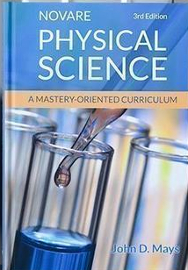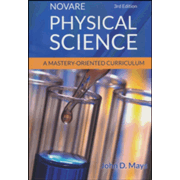John D. Mays, author of Novare Physical Science: A Mastery-Oriented Curriculum, believes that science education needs a total overhaul. He believes that science texts should cover fewer topics, covering those topics in-depth in a way that accomplishes better student comprehension and retention of information. This doesn't mean "dumbing down" science courses; in fact, some students might find Mays' approach more challenging. But if lessons are properly taught, the learning experience is more engaging and motivating.
To that end, in Novare Physical Science, rather than attempting to cover every topic found in most physical science texts for junior and senior high, Mays narrows to fewer topics. He explains that he has based the design of this text on three principles: mastery, integration, and kingdom perspective.
Mastery occurs when students are engaged with the content, reading and applying it frequently. Class discussion, group study, review discussions, review computations, and enrichment activities all help students to achieve mastery.
Integration is accomplished by extending learning beyond the realm of science into history, math, and language arts as well as other subjects.
Kingdom integration helps students develop a Christian worldview that includes the realm of science rather than standing in opposition. Mays challenges students to confront scientific claims that challenge their religious beliefs with scientific evidence and analysis.
Topics covered are sources of energy, conservation of energy, order and design in nature, forces and fields, substances, properties of substances, science theories and truth, measurement and units, force and motion, compounds and chemical reactions, waves, sound, light, electricity, magnetism, and electromagnetism. Christians should appreciate Mays’ explanation of facts, theories, and truth that takes into consideration a biblical worldview, although some might balk at his belief in an old age for the universe. While the “kingdom perspective” is included, it seems to be isolated rather than spread throughout the book. You’ll find it particularly in the fourth chapter, “Order and Design in Nature,” and in the seventh chapter, “Science, Theories, and Truth.”
As you might have gathered, this course is best used in class situations. Discussion should be a major part of the learning experience. In addition, lab experiments seem to be most appropriate for a classroom lab situation rather than homes, although they can be adapted for home settings. For example, experiments use a hot plate and burner rather than a stove as well as beakers, chemicals (e.g., copper sulfate, sodium hydroxide, hydrochloric acid), ring stands, clamps, and other lab equipment. Lab activities require many resources, including the chemicals and lab equipment as well as batteries, a digital multimeter, alligator clips, and other unusual items. A few commonplace items like styrofoam cups and a frying pan are also required. Some experiments require special wooden jigs that require some woodworking tools and expertise to create as well as some metal pieces The twelve lab experiments in the course offer students the opportunity to perform serious lab work that is essential to the course rather than supplemental. Gathering the resources on your own is difficult, so Home Science Tools sells a kit with most of the lab resources you will need. A less expensive kit with just the "special parts" is available from the publisher. Free YouTube videos should also be helpful for some of the more detailed experiments.
Students create lab journals where they record information about their lab experiments. (Instructions for the journal are in the textbook.) Students are also given questions to consider that prompt them to deeper thinking as they write about their experiments. The amount of detail required in lab journals is left for each teacher to determine.
Lab instructions are fairly detailed, but they assume a teacher’s supervision. Consequently, an Experiment Manual and other information teachers will need is available in the Digital Resources for Physical Science. The digital resources for the teacher also include the course overview, quizzes, exams, and answer keys for the quizzes and exams, weekly review worksheets, and a suggested schedule. Some of these are in both PDF and editable Word Document files.
The hardcover textbook is illustrated in full-color. Each lesson begins with a list of objectives and a list of vocabulary terms. Students should probably create vocabulary cards to help them master the vocabulary.
Each section of text within a chapter is followed by a few “Learning Check” questions for students to answer. Chapters conclude with exercises. Answers are included immediately after exercises for computational questions but not for others. The goal of these chapter questions is to prompt discussion and ensure that students have understood the material rather than for grading purposes. Evaluating some of the student responses might be challenging for some parents and teachers who are not chemistry experts. Quizzes and exams also require short-essay-type answers for most questions. That means that the quizzes and exams are effective assessment tools, but they, too, are more challenging for the teacher to evaluate. To make it easier for parents and teachers, on the CD-ROM Novare includes sample answers for Learning Check questions from the text as well as for questions from the quizzes and tests.
Weekly review worksheets in the digital resources can be used for homework to reinforce lessons. These can be used toward establishing student grades along with the quizzes and exams.
Scattered throughout the book are special topics that can be used for additional discussion or investigation—maybe special projects students might pursue individually.
I mentioned integration as a key principle of this course. Part of that integration is the extensive use of math. Students work with basic formulas such as that for computing velocity: v=d/t. Students also practice the conversion of units. They are expected to solve problems in the text such as, “At the hummingbird’s acceleration of 29/m/s [squared], how fast will the bird be going in 250ms? State your answer in m/s” (p. 219) and, in reference to a circuit diagram in the text, “A 12-volt battery is keeping the overhead light on in a car, even though the car’s engine is off. If the resistance of the overhead light bulb is 125 ohms, determine the current flowing in the circuit” (p. 284). You might need to assist some junior high students with some of the math, but high school students should not need help. The inclusion of substantial math in a physical science course is unusual, and it makes the course more challenging than most other physical science high school courses. However, the math reflects the way that science is actually implemented, providing a better foundation for future science studies and real-life applications.
Novare Physical Science is a challenging course, but it is interestingly written. If you can incorporate the teaching strategies Mays suggests, it promises to be a very engaging course for students. Quite a few private schools are using this course, which should give you some assurance as to its quality.











